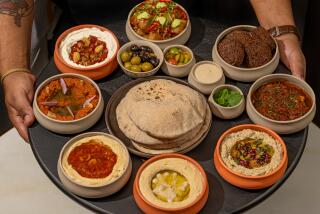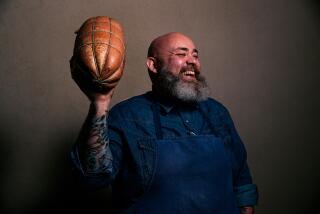When Less Is More
Last spring we spent a few weeks in Forte dei Marmi, on the Italian coast of Tuscany. The Mediterranean shore blended into a flat plain from which rose, about three miles inland, these enormous white mountains.
Not white with snow--it was too late in the season. No, these were mountains of white marble--the quarries that supplied Michelangelo with the stone for his David, the Pieta, the Medici tombs, to mention only a few of his masterpieces.
It’s quite something, driving up the narrowest of roads, trying to imagine huge, unhewn slabs of marble loaded onto flatbed trucks that, during the day, careen--seemingly out of control--down the mountain to the flat plain. Even in the dark of night, the road empty except for a few small passenger vehicles, we hold our breath and call on the fates for protection.
After all, Alex, our host and the proprietor of the Hotel & Beach Club, Villa Irene, our home for the week, had insisted on taking us up to Colonnata for the lamb.
“It’s magnifico, the way she prepares it,” he said. “She does almost nothing to it. Salt, pepper, a little fresh rosemary--but only a little--some wine, vinegar and water. She roasts it whole, slowly, for hours. You’ve never tasted anything quite like it. But still, the lamb is young, still milk-fed. It’s only April, remember.”
We arrived, finally. The apse of the church lent a nice detail to the otherwise forlorn square of the village. And, of course, the entire village was constructed out of--what else?--the white marble.
Entering the restaurant, we were shocked by the ambience: long tables of people passing plates of food and drinking wine and water out of carafes. The padrone pointed us to a table, brought us some wine, water, bread and olive oil, and asked us if we’d be having the roast pork or the lamb. We all opted for lamb.
Then came a series of small plates--cured olives, fresh anchovies in oil with salt, little meatballs with fresh tomatoes, a pasta and, my favorite of all, lardo--paper-thin slices of pork fat, cured and aged like the finest prosciutto ham.
But nothing prepared us for the succulence of the lamb, which had been roasting in the oven for hours. The plates consisted of tender, falling-apart, long-grained meat from the shank; gelatinous chunks pulled from the shoulder and neck; meaty, melting chops cut from the loin; and fatty succulent bits from the belly. The only accompaniment was the few tablespoons of pan juices--not quite a sauce but more fortified than a simple jus. What a meal it was.
If you think that you can’t prepare a similar feast for Easter or Passover, you’re wrong. Your oven may not be large enough to roast a whole animal, but there are easy solutions. First, seek out a butcher who sells milk-fed animals. They’re quite small, but half a carcass will probably suffice. Have him trim the half carcass into three pieces: the shoulder and forearm, the center ribs and loin and, finally, the leg. If you can’t find the baby lamb, pick the smallest leg and shoulder your butcher has.
Begin cooking the shoulder and leg early in the day--count on seven hours in a very slow oven. When they are cooked, remove them and set aside. Then increase your oven temperature to 425 degrees and cook the ribs and loin to a perfect medium.
Round out the remainder of your holiday feast with traditional family favorites.
LAMB COOKED TWO WAYS
2 tablespoons olive oil
1/2 baby lamb (5 to 6 pounds) cut into sections: leg, shank, shoulder with neck and untrimmed rack of ribs with loin
1 onion, finely diced
2 carrots, finely diced
2 celery stalks, thinly sliced
5 whole peeled garlic cloves
1/2 cup dry red wine
1/4 cup balsamic vinegar
1/2 cup water plus extra if needed
1/2 tablespoon salt
1/2 teaspoon freshly ground black pepper
I preheat the oven to a high temperature in this recipe to compensate for the way the temperature drops when you put in a large piece of meat.
Preheat oven to 425 degrees. Heat olive oil over medium heat in heavy roasting pan or Dutch oven. Add lamb leg, shank and shoulder and brown 10 minutes on each side. Pour off all but 2 tablespoons fat. Add onion, carrots and celery; saute, stirring, 5 minutes. Add garlic, wine, vinegar, 1/2 cup water, salt and pepper.
Cover and place in oven. Reduce oven temperature to 275 degrees. Bake 6 1/2 hours or until tender and falling off bone, turning lamb every 30 minutes. Check to be sure that liquid has not evaporated. If pan is dry, add about 1 cup water.
When lamb is tender, remove from sauce. Strain sauce through fine sieve. Discard vegetables. Skim and discard fat from surface of juices. Pour liquid over lamb and keep warm until ready to serve.
Increase oven heat to 425 degrees and roast rack until medium, about 25 to 30 minutes.
To serve, carve lamb into serving pieces and arrange on platter. Pour liquid into sauce boat or bowl and serve on side.
Makes 8 to 10 servings.
More to Read
Eat your way across L.A.
Get our weekly Tasting Notes newsletter for reviews, news and more.
You may occasionally receive promotional content from the Los Angeles Times.








